
www.mangosteen.com

The history and folklore of the mangosteen
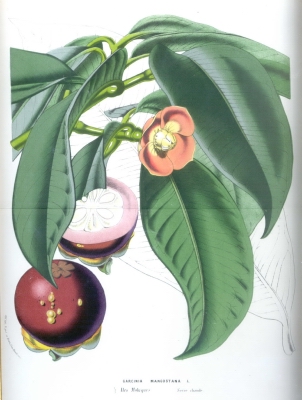
A 19th century print by Louis van Houtte
The history
The gradual increase in awareness of the mangosteen outside of the Malay Archipelago, its native range, was a long and slow process. The few explorers who traversed the seas of Southeast Asia had more pressing issues to contend with than attempting to transport back to Europe and later the Americas an exotic fruit that was so perishable and fragile. Even the seeds die in a week or so if allowed to dry out. There were easier ways to make money. Spices, nuts, precious metals, gems, plant and animal pharmaceuticals and hard goods were all more able to make the long ocean journey back with little reduction in quality. Even so, live mangosteen plants were attempted before the 1800's.
Probably the best bibliography of the historical references to the mangosteen was assembled by Cora L. Feldkamp in 1946 (1). This extensive compilation included, in her words, "references on all aspects of the mangosteen- botany, culture, diseases and pests, varieties, composition, nutritive value, cookery, toxic effects, uses, economics, etc." Much of the web site mangosteen.com relied on the thorough work done by Cora L. Feldkamp. It provided a vast overview of the history of the mangosteen and its steady march towards modern times and greater familiarity in the Western Hemisphere and Europe.
The earlier transportation of plants outside of their native range required a great deal of planning and then luck when the mode of transportation was a boat on the open seas. Beyond the usual basic necessity of food and weaponry, live plant transportation called for more elaborate measures i.e. refitting the ship deck, lining the hull with copper to ward off seaborne wood parasites, designing special plant cases or building greenhouses on deck, storing extra fresh water, etc. Some of the earlier plant explorers did succeed admirably in getting their accessions back to their home countries or colonies. Sometimes the accessions changed ships in transit when a homeward-bound vessel aided a fellow countryman in getting their collected material back to the mother country. And sometimes the collected material became the property of a different country as a result of piracy. In this regard, the Spanish, French, Dutch, British, Portuguese and others all vied for control of different regions of the world and strove to create monopolies in any and all commodities (2). The spice trade, furs, gums and waxes, natural dyes, ivory, silk, cotton and coffee comprised much of the cargo at sea in those times. A gradual trend was emerging where the control of a commodity was more manageable for a colonial power than absolute control of the people of a colony or possession and treaties for this purpose abounded. In the decades following their loss in the Revolutionary War, the British set to the task of exploring and strengthening their grip on particular trade routes on the seas. Plants were not only transported back to home countries from afar (3). Many colonizers also took plants and livestock the other way, 'seeding' the islands along the routes to try and ensure a food supply in both directions and a means of barter as well. Horses, pigs and goats were presented as gifts to secure certain trade privileges and the result was a movement of germplasm of many species outside of their native ranges that would never be allowed today. The focus of this web site, the mangosteen, was just a bit player in this drama but played a role nonetheless.
The records that detail the movement of the mangosteen during the 18th and 19th century (2,3,4,5,6,7,8) indicate that the first introduction of the mangosteen in the UK goes back to someone named Anton Pantaleon Hove. A. P. Hove (alternately Hoveau) was a Pole dispatched by Sir Joseph Banks to go and try to 'obtain' some better strains of cotton seeds from Gujarat, India. Apparently amongst his procurements were mangosteen plants that made it back to Plymouth, England in 1789 and which were then moved to Kew. Sir Joseph Banks, whose widespread popularity and renown resulting from his accompanying Captain Cook on his first expedition, was then head of the Royal Botanical Gardens at Kew and president of the Royal Society. Banks was very actively involved throughout this period in guiding, consulting on and sometimes personally funding projects involving both plant and animal introductions. Slowly but surely, the effort was being made to introduce the mangosteen into the Western Hemisphere.

From "Flore medicale des Antilles" 1821*
With regard to the history of the mangosteen, it should be noted that it was the other plant under consideration in an 18th century publication (7) titled "A description of the mangostan and the bread-fruit" by John Ellis (mangostan was the word for the mangosteen in the Molucca Islands). The year was 1775 and John Ellis was utilizing his knowledge of the tropics as a fellow of the Royal Society Of London to expound upon the botanical treasures of far off Africa and the Malay Archipelago. The original intent of this work was to inform his Majesty "The Earl of Sandwich, First Lord of the Admiralty of GREAT BRITAIN" of a prospect that "seems conducive to the benefit of any part of the British Empire..." This publication also detailed with sketches of designs of several wooden plant cases with wire mesh that would house the plants on the deck of a ship for the journey home. There was also a stylized sketch of the breadfruit and the mangosteen in this publication. See below.

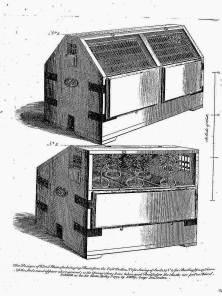
Cabinets designed by Ellis to hold plants on the upper decks of a ship.

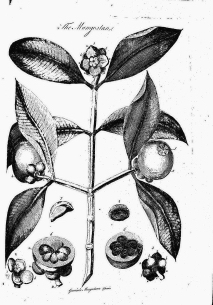
The four illustrations above are from the work by John Ellis (7) from 1775.
Ellis makes reference to Laurent Garcin, a French naturalist who traveled through the region in question collecting and describing the native plants in general and the mangosteen in particular. Linnaeus, a regular correspondent with Ellis, honored the work of Laurent Garcin by naming the genus Garcinia which includes the mangosteen after him (9,10). It is the glowing description of the mangosteen fruit by Garcin, Rumphius, and others that led Ellis to place it alongside the breadfruit as a candidate for retrieval and planting in the British colonies of the Caribbean. The publication of this paper was intended to encourage the funding of an expedition to the "East Indies" to bring back these two plant species, the mangosteen and the breadfruit, to the West Indies for planting and cultivation. In this it succeeded. The individual chosen for this journey based on the conclusions of this publication was none other than Captain Bligh (11, 12). The British government in 1787 informed the West India Committee, a British plantation owners' lobbying organization in competition with the Royal Society of the Arts, that they would provide funding for this expedition. They purchased a ship commissioned as the "Bounty" for this purpose. As many know, Bligh needed more than one attempt but did ultimately succeed in bringing back the bread fruit on the ship Providence. For this Bligh received the Gold Medal from the Royal Society of the Arts in 1793. Breadfruit then became widely established throughout the Caribbean and Latin America. The same success and notoriety could not be said for the other candidate in John Ellis' work, the mangosteen, at that time.
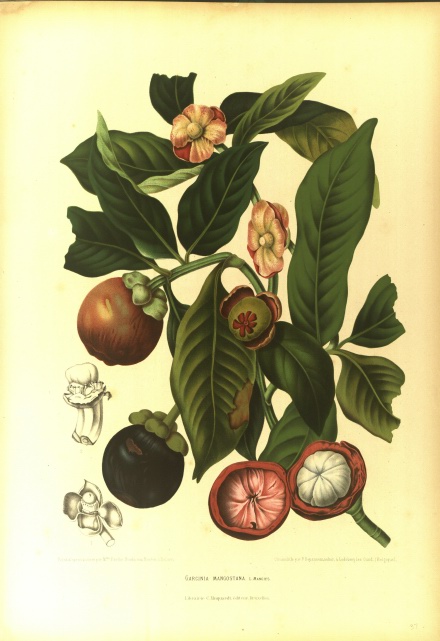
Highly detailed mangosteen print from 1880 by Berthe Hoola van Nooten*
The references to the mangosteen remain somewhat sparse from the end of the 18th century to the mid-19th century. One event that stands out is that of the first recorded fruiting of the mangosteen in the United Kingdom in 1855. This feat was accomplished at Syon Park, the ancestral home of the Dukes of Northumberland, by their highly skilled gardener John Ivison (11, 12). The greenhouse complex was heated to maintain a steady tropical temperature to offset the temperate British climate and this was managed in what were then known as stove houses. The seeds were obtained, so the article goes, by a Captain White from Calcutta in 1833. Based on this and other articles around that period, the timeframe would be that flowers formed on one or both of the two trees grown in large tubs in November of 1854. This would work out about right for fruit approximately 120 days or more later. It was stated that the tree with the flowers was about 15' high and 9' wide (a field grown tree in the tropics can produce at a much smaller size and in fewer years) but to pull this off in a greenhouse was quite an accomplishment. It was acknowledged as such by the Royal Horticultural Society at the time. The fruit received the Gold Banksian Medal, the first time such an honor was attached to a single fruit. It is claimed by numerous web sites that Queen Victoria was in attendance when the fruit was presented but in point of fact there is no proof of that and the Queen most likely was not. This would have been too newsworthy for the press to have ignored it in the articles of the time and none substantiate this claim. The Royal Archives recently found a letter from Eleanor, the Duchess of Northumberland, addressed to Queen Victoria explaining that based on her (Eleanor's) glowing description of the mangosteen to the Queen at a subsequent gathering, "...I now venture to ask to be allowed to send to your Majesty, a Fruit of the Mangosteen, which has never been known to fruit out of its own country; and this is therefore an object of very great curiosity and interest among Botanists." Why would she offer to send one if the Queen had already been at any ceremony based on the fruit of the mangosteen? This letter is from May 7, 1855 and there is no documented proof at this time that the Queen ever received the fruit or tried it if it arrived. A good day to be a court taster! So it is possible that Queen Victoria tried a sample sent over to her by Eleanor, Duchess of Northumberland, but there is no documented proof of receipt at this time or tasting of the mangosteen by the Queen in 1855. None whatsoever.
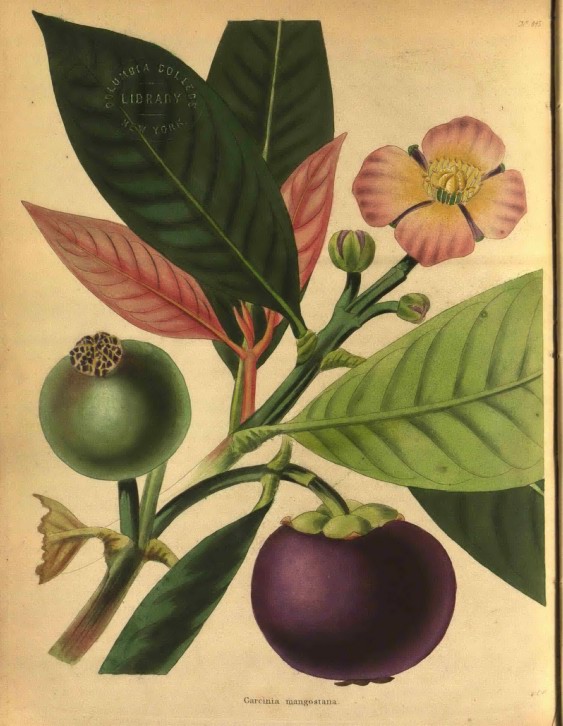
1824 print; Loddiges, Conrad and sons*
And some folklore...
Before reading this next section, take a moment and do a search on any search engine for the following. First, look for "Queen Victoria" and you will see hundreds or thousands of relevant hits on this topic. Then alter the search by adding the '+' symbol or the word AND and the word "mangosteen" and voilß. The connection between the mangosteen and Queen Victoria is on hundreds, thousands of web sites... As far as I can tell, there is no such connection at all. I will gladly receive any verifiable documentation that proves me wrong and rewrite this part of the mangosteen.com web site immediately.
The lingering conviction that the Queen was in attendance was again resurrected in the 19th century by W. Higgie in the Gardener's Chronicle 37 years later (13). He asserts, I believe incorrectly, that the Queen was in attendance at the ceremony and first tried this fruit produced by the Northumberlands in 1855. I say incorrectly for two additional reasons. First, I received from the Royal Archives (14) a letter dated 31 March, 2005, in which the Registrar states "...I cannot find any reference to mangosteens in connection with Queen Victoria" in their archives. And the second reason is because of an 1891 paper (15) by J. H. Hart. Hart was writing in Trinidad about the request of his visitor, Sir F. Napier Broome, K.C.M.G., to try and transport back to England a mangosteen for the Queen to sample. This would have been the second attempt to transport mangosteens to England from Trinidad. The first attempt (16) was made in 1875 when this mangosteen tree first flowered and fruited. Mr. Henry Prestoe, Hart's predecessor as curator of the Trinidad Botanic Gardens, succeeded in getting them to the UK. The two fruits sent by Prestoe did arrive somewhat worse for wear but the Queen was not recorded as having been a recipient at that time. The writers of the Gardeners' Chronicle received both fruits and ate them, reporting on the sweet flavor after the long journey. However, in 1891, Sir Broome asked to try again.
"...His Excellency expressed the wish to take some of the fruit with him, with the view of presenting it to the Queen, it being reported that the Mangosteen was almost the only fruit worth eating, which her Majesty had never tasted."
Upon arrival in the UK, the fruit was forwarded to Queen Victoria in residence at the time in Balmoral Castle and her personal secretary Henry F. Ponsonby sent a letter of thanks to Sir Frederick Broome informing him that;
"I am commanded by Her Majesty to thank you for these Mangosteens, and I may add that the Queen says at the same time "they were quite excellent." "
Hart goes on to wonder if Trinidad can lay claim to being the first of Her Majesty's "possessions" to afford her the opportunity to try the mangosteen. I think I can state that the Queen was not in attendance when the Syon fruit was unveiled but if the Queen did try this fruit prior to the shipment from Trinidad in 1891, no one as of this writing can prove it.
There was one tantalizing clue in a book review that suggested Queen Victoria had tried the mangosteen earlier than 1891. It was brought to my attention recently and I should clear up this confusion here and now. The book in question (17), "Maharanis: The Extraordinary Tale of Four Indian Queens and Their Journey from Purdah to Parliament" by Lucy Moore is an excellent read and insightful view of the times. The book review written by Kate Chisholm can be found in the Sunday Telegraph, 8/29/04, and she refers to the Queen "enjoying the taste of exotic fruits such as rambutans and mangosteens shipped over specially for her delectation..." Unfortunately, according to the author Lucy Moore (pers. comm.), these are not the words of the author but rather those of the reviewer and do not appear anywhere in Lucy Moore's book.
One also can not prove that Queen Victoria ever offered any rewards whatsoever to the first person who could bring her a fresh mangosteen. Believe me, I tried to locate proof of this (see below). The alleged offers of a knighthood, money and so on are at best apocryphal and appear to be the creative work (18) of David G. Fairchild.
Fairchild was a fervent promoter of agriculture and a towering figure in the history of plant collecting from around the world and their subsequent introductions in the United States. The namesake behind Fairchild Tropical Botanic Garden in Miami, Florida, he left behind an extraordinary legacy and wealth of papers, diaries, notes and book drafts that is a treasure trove for students of American history and agriculture. I am greatly indebted to this institution and the very knowledgeable curator of the archives (see Acknowledgements) who enabled me to make an appointment to spend an entire day poring over the works on their shelves. David Fairchild also played a key role in an expression seen on tens of thousands of web sites;
"Mangosteen, the queen of tropical fruit"
Alternately written "mangosteen, the queen of fruit" by Fairchild himself, it is hard to convey the extent to which this quotation has caught on with sellers of processed mangosteen products until you take a moment with a major search engine on the internet. You can search just the word <"mangosteen"> or <"queen of fruit"> or <mangosteen +queen> and you will see thousands of sites promoting mangosteen-related products (see Science, non-science and nonsense). Heck, you can even search for <"spam spam spam and the queen of fruit"> and you will see thousands of references to the mangosteen... This phrase, as far as my research has taken me, was first coined by David Fairchild in 1903 to attach august or royal attributes to a fruit he thought very highly of (19). The connection between the "queen" in this quote and Queen Victoria is also apparently internet fiction. See below.
In his extensive travels around the world Fairchild had ample opportunity to try just about every fruit imaginable in dozens of countries both tropical and temperate. His conclusion was that of all the fruits he tasted, the one that earned his highest praise was the mangosteen. In Fairchild's book (18) "Exploring for plants" published in 1930 by Macmillan, he makes the first reference to the mangosteen on page 7 as "the queen of tropical fruit." Fairchild then goes on to elaborate on page 18 and states that Queen Victoria "once offered 100 pounds to anyone who would bring her one." He also states that the Duke of Northumberland in 1855 had two trees each with one with fruit and he personally presented Queen Victoria with one fruit and held a banquet in honor of the other one. None of this is substantiated by any known data base including the British Natural History Museum, Kew Gardens, the Royal Archives, The Times of London, the British Library, Gardener's Chronicle, Curtis's Botanical Magazine or any other known print medium of the times. So his conjecture is possible but highly improbable given that it appears undocumented and uncited.
It is also highly unlikely that Queen Victoria has anything whatsoever to do with the expression "Queen of tropical fruit" and the mangosteen, as is stated on hundreds of web sites. Again, no citation, no historical proof and the earliest sign of this quotation is that of Fairchild. Just a leap on the part of those with a fertile imagination and no time to do research, apparently. It seems more likely that mangosteens have been 'the fruit of queens' than the other way around.
I offered a reward on Google in September of 2005 to anyone who could find the citation substantiating claims of rewards by Queen Victoria for the mangosteen and there were no takers from anywhere in the world. The reward stands; I will offer U.S. $100.00 to the first person only who can locate and provide me with or direct me to the written document from before the beginning of 1901 that substantiates Fairchild's claims regarding Queen Victoria and the rewards offered. I will then rewrite this section of the web site! But don't hold your breath.
There is more. The "queen of fruit" is how David Fairchild refers to the mangosteen (20) in 1915 and the word "tropical" has been dropped, only to reappear later. Why does it matter? It is quoted on thousands of web sites both ways largely to promote processed mangosteen products in many cases without attribution to Fairchild or with attribution to Queen Victoria. And Fairchild was only referring to the fresh fruit, not any processed fruit and certainly not any processed whole fruit!!! Along with this are the oft-cited offers of rewards by Queen Victoria and there is not one whit of evidence to back this up. To date, none. See my page Science, non-science and nonsense. I don't expect this web site to change any of that. I am simply another voice weighing in but one that did the original research and did not simply repeat the unfounded, uncited, baseless speculations of marketers of mangosteen products repeating each other as sources. Or just making it up.
One can not rule out the possibility that the origin of this quote "mangosteen, the queen of fruit" is in fact a translation of perhaps an old Thai or Malay expression. Maybe it dates back to colonial times and early explorers first encounters with the mangosteen. The first European to try the fruit may simply have been translating the local expression of praise for this fruit. I have attempted repeatedly over the years to determine whether this was the case but inquiries made to both Thailand and Malaysia have never been responded to. I contacted universities and professors, government agricultural agencies and their scientists, tourism officials and consulates here in the States; nothing. It must have been a language barrier. Or perhaps they just thought I was nuts. The only responses I ever received were from 2 bloggers and a writer of a newsletter and for that, my thanks.
One final note about the quote "queen of fruit." Depending on where in the world you are sitting while reading this, the "queen of fruit" could be historically one of your own local fruits. The pineapple, grape, apple, mango (India), peach (US), apricot, quince and who knows how many other fruits have all been referred to as "the queen of fruit." And on and on. Alfred Russell Wallace in his "Malay Archipelago" (21) thought of the orange as "the queen of fruit", pairing it with the durian as the "king of fruit." And in the Philippines, the mangosteen was referred to as... the King's fruit!

A photo of both the king and queen of tropical fruits. Durian, the king, is in the background.
Some odd coincidences have appeared during my research regarding the mangosteen. In the last two centuries it was the name of a race horse twice and the first time was in 1844. Curious to know why, back in 1844 a word this unusual would be applied to a horse, I contacted the Thoroughbred Heritage in the UK with this very question. My thanks to Patricia and the Thoroughbred Heritage of England. The horse Mangosteen had relatives that, in keeping with a habit of the times, preserved the food theme and the other horses had names like Morel, Truffles, Mustard and so on. The second horse named Mangosteen ran in the US in the 1930's.
It would be incomplete not to mention some of the other early explorers that braved the remote, sea snake infested, malarial and seasonally cyclone-prone Malay Archipelago and seas of Southeast Asia in pursuit of discovery, collection and documentation of their travels. Truly intrepid plant explorers such as F. W. Burbidge(22), Monsignor Jean-Baptiste Pallegoix(23), Henri Mouhot (24), Odoardo Beccari (25), Eric Mj÷berg (26), and William Roxburgh (27) provided us with the earliest records of Europeans eating and enjoying the fresh mangosteen in its native environment. Burbidge, commissioned by the British firm Veitch and Sons, explored Borneo and described the flavor of the mangosteen as;
"...something like that of the finest nectarine, but with a dash of strawberry and pine-apple added."
Pallegoix in Thailand also weighed in, trying to describe the flavor;
" They exhume a sweet perfume approaching that of the raspberry and have the taste of strawberries."
Odoardo Beccari traveling through Borneo also waxes lyrical and it should be noted that these explorers all shared a temperate climate orientation and thus chose that reference point to help them describe this tropical fruit. Beccari summons a few of them;
"...an abundant white, juicy pulp, soft, sweet, slightly acidulated, and with a delicate, delicious flavour, which recalls that of a fine peach, muscatel grapes, and something peculiar and indescribable which no other fruit has."
Eric Mj÷berg spent a brief period at Kew Gardens, during which time he met many of the luminaries of science in that day. But the one contact that he made there that was to facilitate his travels to Sarawak was his timely meeting with James Brooke, the Rajah of Sarawak. Of this fruit, Eric Mj÷berg said;
"The mangosteen has only one fault; it is impossible to eat enough of it, but, strictly speaking, perhaps that is a defect in the eater rather than in the fruit."
Further along he states;
"It would be mere blasphemy to attempt to describe its wonderful taste, the very culmination of culinary art for any unspoilt palate."
And finally he states;
"It has been credibly asserted that the mangosteen was the one fruit that Queen Victoria could not have served at her table."
Enough said.
Bibliography
1) Feldkamp, Cora L. The mangosteen: a list of references. U.S.D.A. 1946. Washington, D.C.
(2) Mackay, David. In the wake of Cook; exploration, science & empire, 1780-1801. St. Martin's Press. New York. 1985
(3) Wade Graham, Traffick According To Their Own Caprice: trade and biological exchange in the making of the Pacific World, 1766-1825. Seascapes, Littoral Cultures, and Trans-Oceanic Exchanges. 12-15 Feb. 2003. Library of Congress, Washington D.C., 12 Dec. 2005 <http://www.historycooperative.org/proceedings/seascapes/graham.html>.
(4) Carter, Harold B. Sir Joseph Banks,1743-1820: A guide to Biographical and Bibliographical sources. Saint Paul's Bibliographies. Winchester, UK. 1987.
(5) Aiton, W. Hortus Kewensis: or a catalog of the plants cultivated in the Royal Botanic Garden at Kew. Ed. 2, 5 v. London. Printed for Longman, Hurst, Rees, Orme and Brown, 1810-1813
(6) Miller, Phillip. The gardener's and botanist's dictionary. Thomas Martyn Edition. 1807
(7) Ellis, John. A description of the mangostan and the bread-fruit: the first, esteemed one of the most delicious; the other the most useful of all the fruits in the East Indies, to which are added, directions to voyagers for bringing over these and other vegetable productions, which would be extremely beneficial to our inhabitants of the West India Islands, with figures. 47p., illus. London. 1775
(8) On the cultivation of the mangosteen and nearly allied species, as fruit trees. Paxton's Mag. Bot. 15:205-207, illus. 1849
(9) Garcinia mangostana L. Species Plantarum 1: 443-444. 1753
(10) Mangostana. Garcin, Philos. Trans., 38: t. 1, 1734
(11) Douglas O. Linder, The Mutiny on the Bounty: A Chronology (2004),
http://www.law.umkc.edu/faculty/projects/ftrials/Bounty/bountychronology.html
(12) Aspinall, Algernon. The Bread-Fruit Tree; Introduction into the West Indies. The Times, Thursday, Feb 06, 1936. Pg 10. Issue 47291; column C)(Aspinall, Algernon. prior citation The Times, Saturday, Jan 02, 1932; pg. 6; Issue 46020; col C
(13) Mangosteen. Gard Chron. No. 22, p. 371-372. June 2, 1855
(14) The mangosteen- Garcinia mangostana. Florist, Fruitist, etc.) (Gard Chron. No. 22, p. 371-372. June 2, 1855)
(15) Higgie, W. Fruits of the mangosteen. Gard. Chron. (ser. 3) 12:136. July 30, 1892
(16) The Royal Archives, 31 March, 2005. The Royal Collection Trust, Windsor Castle, Berkshire, UK. Letter from the Registrar (of the Royal Archives) responding to my request for information in their archives. I was attempting unsuccessfully to ascertain if there was any connection between Queen Victoria and the mangosteen.
(17) Hart, J. H. The mangosteen (Garcinia mangostana). Trinidad Cent. Agr. Bd. Agr. Rec. 5: 176-177. Nov. 1891.
(18) Prestoe. The mangosteen of Singapore. Gard. Chron. (n. s.) 4: 656-657, illus. 1875
(19) Moore, Lucy. Maharanis. Viking Penguin. 2004
(20) Fairchild, David G. Exploring for plants. Macmillan Company. New York. 1930
(21) Fairchild, D. G. The mangosteen, queen of tropical fruits. Soc. Hort. Sci. Proc. (1903): 14-15. 1905
(22) Fairchild, D. G. The mangosteen. Jour. Hered. 6: 339-347. 1915
(23) Wallace, Alfred Russell. The Malay Archipelago; the land of the orang-utan and the bird of paradise. A narrative of travel, with studies of man and nature. First published in 1869 by Macmillan. London
(24) Burbidge, F. W. The gardens of the sun. Oxford University Press. 1991. First published in 1880 by John Murray, London
(25) Pallegoix, Jean Baptiste. Description of the Thai Kingdom or Siam. P. 67. Translated by Walter E. J. Tips. White Lotus Press. 2000. Originally published as Description du Royaume Thai ou Siam, 2 volumes, 1854, Mission de Siam, Paris
(26) Mouhot, Henri. Travels in Siam, Cambodia, Laos and Annam. White Lotus Press. 2000. Originally published in 1864 by Murray, London
(27) Beccari, Odoardo. Wanderings in the great forests of Borneo; travels and researches of a naturalist in Sarawak. A. Constable & Company. 1904
(28) Mj÷berg, Eric. Forest life and adventures in the Malay Archipelago. P.152. William Morrow & Company. New York. 1930
(29) Roxburgh, William. Flora Indica or descriptions of plants. Kessinger Publishing at www.kessinger.net
*The color prints above are scans obtained with permission from;
The LuEsther T. Mertz Library
New York Botanical Garden
Bronx, NY 10458-5126
These images are not to be reprinted in any form or extracted for any use without first obtaining permission in writing from the LuEsther T. Mertz Library.
In the order in which they appear above;
van Houtte, Louis. Lemaire, Charles. Flore des Serres et des Jardins de L"Europe, ou descriptions et figures des plantes les plus rares et les plus meritantes, nouvellement introduites sur le continet ou en Angleterre, et soit inedites, soit extraites des meilleurs recueils de botanique et d"horticulture. Ser II, xii, t. 2359, 2360. 1876
Descourtilz, Michel Etienne. Flore pittoresque et mÚdicale des Antilles, ou traitÚ des plantes usuelles des colonies franšaises, anglaises, espagnoles et portugaises; par M. E. Descourtilz. Volume 1-2. 1821
van Nooten, Berthe Hoola. Fleurs, Fruits et Feuillages Choisis de la Flore et de la Pomone de l'Ile de Java Peints d'Apres Nature. 3 ed. 1880
Loddiges, Conrad and Sons. The Botanical Cabinet Consisting of Coloured
Delineations of Plants from All Countries, with a Short Account of Each,
Directions for Management, Etc. Pritzel (2nd ed.) ix t. 845. 1824